Bam – The Flattened Civilization
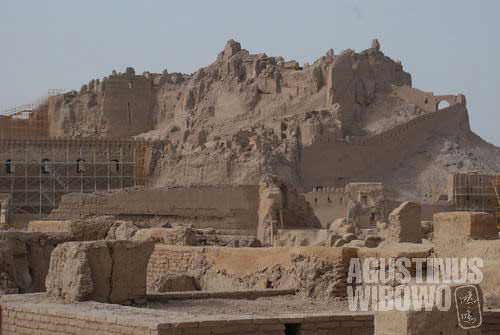
From what is left, you still can be amazed by the grandeur of an advanced ancient civilization
27 December 2003, the small town of Bam – located in southeastern Iran, about 300 kilometers from Kerman – was shocked by 6.8 Richter-scale earthquake. More than 40,000 were killed. Asides of the human casualty, Iran has another thing to grieve, as one of its civilization jewels was nothing but flattened.
The ancient mud city of Bam used to be one of the strongest tourism magnets in Iran. People claimed it has 3,000 years of history, at least from the Sassanian period. Thousands of interesting old mud houses, sprawl under a giant mud citadel, giving exotic fairytale impression. I adore the old pictures of Bam, which are still hanged everywhere to remind how majestic the place used to be.
But, the view of Arg-e-Bam (the ancient citadel surrounded by the mud city) today makes me weeping.
The place is in severe desolation. The citadel which was appraised by Marco Polo and other ancient travelers now turned to be rubble. The old town become sad crumbling remains and debris. Workers are everywhere, hoping to restore the old town to its ancient glory, but not with much optimism.
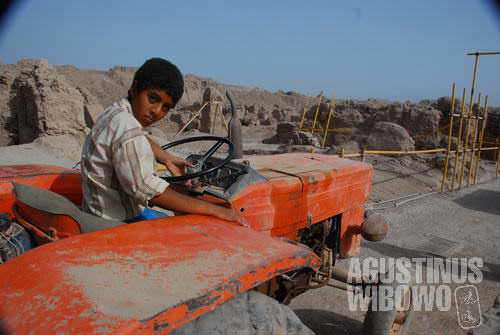
Afghan construction workers in the historical site
“It is a hard work,” says Muhammad, a 38-year-old guard working in the reconstruction site, “as you see, it’s a very huge area. The old town sprawls 500 meter long to the citadel, and the width is more than 700 meter. To restore every single building here needs so much time. And there are thousands of them.”
As reminder of the old glory, the authority builds a replica of the Arg and the mud town, now being kept under a tent. Only the Arg replica was finished, and it took already one and half year to build.
“Even for a small replica like this take such long time, no need to mention how much time it will take to restore the real old town.”
The reconstruction has been conducted since four years ago. The most optimistic time frame to finish the project is another 15 to 20 years.
Inside the walled town, tourists are now allowed to get near the Arg through designated pathways. It is a very restricted movement, but considering archeological restoration is still being held on site, it’s better to prevent it from more destructions of careless visitors.
“Chetor asti, vatandar! How are you, my compatriot?” greets an Afghan Hazara worker, feeling happy to hear I speak Afghan-accented Persian. He drives tractor, loading stones and mud clays to the Arg site. He is among dozens of blue-uniformed reconstruction workers, working from early morning to late afternoon.
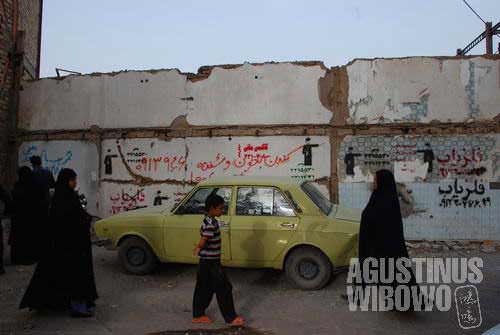
Some scars of the disaster in the city of Bam
Another Afghan worker from Mazar-e-Sharif, initially introduced himself as Mohsen Zabuli and claimed to be Iranian, happily shows me some restricted areas for casual visitors. He also does not know when the project will finish. He just does his duty and gets money, about 100,000 Rial daily (approximately 10 dollars), but some workers here earn as few as 3 dollars per day.
“Why I came here? Because there is no work in Afghanistan. In Iran, [job] opportunity is abundant.”
Mohsen Zabuli’s real name is actually Abdullah. The Afghans have characteristic of preference to have ending –ullah (from Allah, God) in their names. He then changed his name to be more Iranian, and now he is a legal Afghan worker here.
Dust flies along with the infamous desert wind. The flattened ancient mud town of Bam starts to rise again, slowly.
“Have you seen the Arg? What do you think about that?” asks a local man on Bam quiet road after I left the historical site. “It used to be very beautiful. But when the earthquake destroyed it, I felt my life had also gone.”
The quake did not only destroy the ancient civilization, but also destroyed his entire life. “I lost everything. Fifty people, fifty, from my [extended] family died. My heart was broken. You asked me how many days I cried. I cry even until now.” Abbas, the 60-year-old man weeps, “I have been crying for five years. My heart is not calmed yet.”
I remember the days when I work as disaster volunteer in post-tsunami Aceh, where people were still weeping telling their glorious past-days and tragic todays, but smiles still flashes across faces where little hopes rise from the rubbles.
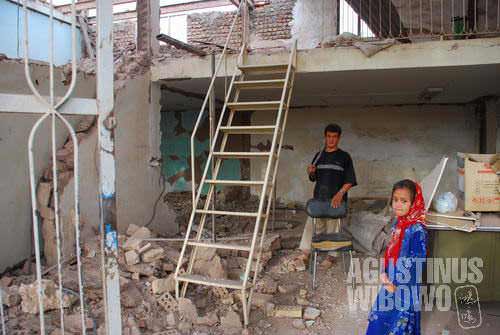
Rebuilding from the rubbles
“Life has to go on anyway,” says Abbas, now owner of a glass shop next to the main street.
Like Abbas, Mohammad the guard just has to receive the fate. He complained on how the aid money was corrupted by the government, and it was shameful that actually Japanese and American aid was the first to arrive, even the reconstruction of the historical site was done on Japanese or Korean funding. Tents and clothes for Bam victims were sold in Bandar. Some gold sellers in Mashhad donated 1 million Rial each, but he claimed that none of the money arrived to Bam.
But some optimism is needed to build the future of Bam. Panjali Akbar, known better as Akbar English, was an English teacher who built the most famous backpacker shelter in Bam. His guesthouse used to be very successful, catering more than 30 travelers daily. As other things here, the guest house was flattened by the earthquake.
“I always try to be optimistic,” says him in contemplation. He reopens his guesthouse three days right after the disaster, providing a simple tent for foreign visitors. Now the situation is better, he has dormitory room for five people and separate single rooms. But tourists never flood anymore. “Usually we have three to four tourists staying here per day, but it’s not uncommon to have nobody at all.”
It is not completely because the quake. Actually, right after the disaster, foreigners still did come. Year after year, the number of visitors decline sharply. Iranian foreign policy has put off many of potential visitors. The worsening security in neighboring Pakistan and volatile Afghanistan does not help either. Several weeks ago, a Japanese tourist was kidnapped in Bam, suspected done by drug smugglers for ransoms, as they were enraged by the anti-drug police action. Foreigners then were not allowed to venture in Bam without escort. The law was just lifted two days ago.
“It was not really nice to go everywhere with a boring and bored police guy,” murmurs Sjef who drove his car from Holland overland until India, together with his wife Saskia and their cute dog.
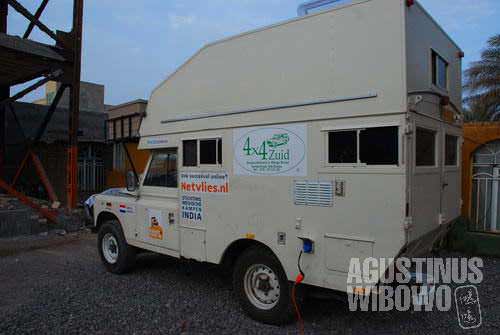
Travelling around the world all the way from Europe, and passing through sensitive border zones
Not only traveling in Bam was restricted, the main road to Pakistan border, passing through Zahedan in Balochestan province, is also sensitive area as well. Foreign travelers have to be escorted by Iranian soldiers in that whole track. I met two other Australian motocyclists who confirm the security situation today. The police apparently still worry on kidnapping risk upon foreign tourists – an easy hard money source of income for illegal drug smugglers along the impoverished province near sensitive borders with Pakistan and Afghanistan – the biggest opium produce on earth.
Earthquake has changed life here. Roads and new buildings testify new hope for the future. Tents disappeared, debris are removed. But tears are still here, along with dirty money from illegal business But Bam will surely stand up again from its rubbles.






Leave a comment